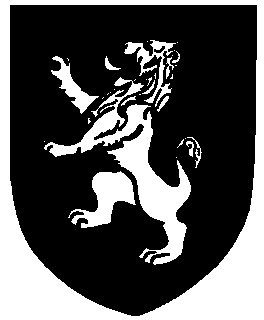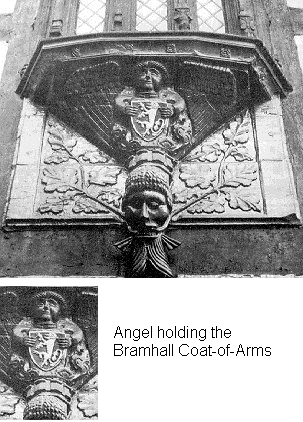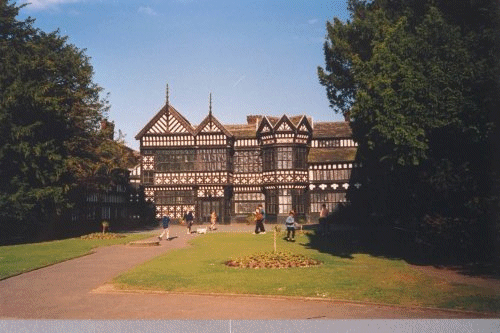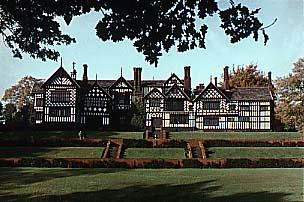
The Bramhalls
of
Bramhall Hall/Manor

Bramhall, England
The Bramhall Mystery
The only written record known thus far explaining why the Bramhall family of Bramhall, England and their holdings disappeared in history indicates, that one of the two daughters of Goeffrey de Bromale, Alice, married John de Davenport in 1350. Since Geoffery de Bromale is purported to have had no male heir, it is reported that the Bromale (Bramhall) estate went with Alice into the Davenport family and that over the next six centuries, the Davenports built what is primarily today called Bramhall Hall. This may or may not be true. There is another factor that merits much research and may never be proven as fact, but should definitely be considered. The following are perplexing questions concerning the Bramhall family and possible answers to the mystery of the disappearance of this family in the very town that has born their name for almost one thousand years.
Did the Bromale (Bramhall) family participate in the Crusades? They were English gentry, wealthy, powerful, and religious. It is probable that some members of the family did, as their family profile indeed does fit those of English knights who joined the Crusades.
Did the Bromales (Bramhalls) become members of the most famous knightly monastic order of the Crusades known as the Templar Knights or Knights of the Temple? If they were affiliated with this order, the disappearance of the family line in 1350 and/or the family estate being put into the hands of the Davenport family would be consistent with events taking place at that time in European history. It would also explain the newfound recognition given to John Bramhall in 1628 by the Royal College of Heralds through which his line is recognized as "descended from the ancient family of Bramhall, of Bramhall, county Cheshire," and restoring to him the same coat-of-arms or arms and crest (crescent on a field of sable, a lion rampant).
Why are the dates of 1350 and 1628 key factors in possibly linking the Bramhalls to the mysterious Templar Knights and giving an alternate plausible explanation to the family's disappearance for more that two centuries? The Templar Knights during the years of the Crusades (1096 - 1291) became the most powerful financial force in Europe. After the Christian Crusaders were expelled from Palestine for the last time in 1291, over the next few decades the Templar Knight came to be known in Europe as the "King Makers." They often underwrote kings and entire countries because of their wealth and prestige. Because of this power and prestige, King Philippe IV of France and Pope Clement V (cousins) conspired to bring the Templar Knights under the deadly scrutiny of the Inquisition of the Roman Catholic Church. Their intent was to do away with their order and confiscate their massive wealth. They appear to have accomplished neither of these two objectives, even though they used the Roman Catholic Court of the Inquisition to murder Templar Knights over the next years. Jacques de Molay, the Grand Master of the Templars, was burned at the stake in France in 1311. Templar Knights throughout all of Europe went into hiding. The Pope declared that any fugitive Templar who did not surrender by May 6, 1314, was automatically subject to death at the stake by fire. The Templar Treasury in France was bare when King Phillipe's soldiers showed up -- whisked out of the country on the Templar's fleet of ships before their arrival. Where the massive amounts of gold found in this treasury disappeared to is still one of the enigmas of history. The Inquisition against the Templars gradually spread over all of Europe.
A powerful Templar organization had existed in England. The inquisition of the Templar Knights had started in France in 1309, but was slow in reaching the rest of Europe. By the time it arrived in England, most known Templars has disappeared, as was the case in much of the rest of Europe. These men went underground by changing their family names and/or by putting their lands and holdings in the care of other trusted English family names. Is this what happen in 1350 when the Bromale (Bramhall) name ostensibly merges into the Davenport family?
These underground Templar Knights eventually formed a powerful, clandestine organization to protect themselves and their families against the onslaught of the murderous Inquisition. They used secret signs and symbols to identify each other and to obtain refuge and protection. Many of these signs and symbols are believed to have come from the ancient ceremonies of the Temple of Solomon, which the Templar Knights learned while occupying the Temple Mount in Jerusalem for almost 200 years of the Crusades.
This new organization evolved and eventually came to be known as the Mason's Guild (Union). In consisted not only of stone cutters and brick layers, but of architects, structural engineers, civil engineers, etc. They designed, financed and built most of the magnificent, public and religious buildings constructed throughout Europe during two centuries. As time passed, the struggle in England to negate the power of the Holy See (the Roman Catholic Pope) in the political affairs of England succeeded. The Reformation and the establishment of protestantism took place. By the early 1600s the power of the Catholic Inquisition in England was neutralized. In 1627 the Mason's Guild declared itself publicly as the FREEMASONS, an organization descending from the Temple of Solomon through the Templar Knights. Is it a coincidence that John Bramhall is recognized by the English Government in 1627 as -- "descended from the ancient family of Bramhall, at Bramhall, county Cheshire," and restoring to him the same coat-of-arms or arms and crest (on a field of sable, a lion rampant). John Bramhall was a very powerful man. He served as Dean of Ripon, Bishop of Derry, Speaker of the Irish House of Lords, Archbishop of Armagh and Lord Primate of Ireland.
The above information gives plausible explanation to many questions about the history, or lack thereof, of the Bramhall family from 1350 to 1628. Some of these explanations could be as follows:
1. The Bromales (Bramhalls) did indeed participate in the Crusades where they became Templar Knights.
2. As members of this organization in the early 1300s, they were threatened with extinction by the Papal Inquisition and were forced underground by 1350.
3. It may not be coincidence that Geoffery de Bromale, who's daughter (Alice) married into the Davenport family at the time of the persecution of the Templar Knights, had the same first name (Geoffery) as many of the leaders of the Templar Knights from its founding in Jerusalem (1118) until its demise in the 1300s.
4. The Bramhalls continued on through the Davenport family name in a variety of possible arrangements, some of which could have been changing their name, titles and holdings to the Davenport name, linking entrance into the Davenport family by marriage and falsifying records putting an end of the Bramhall line because of no male heirs. There are many other possibilities. How would you have done it?
5. It is interesting that the Davenport coat-of-arms (three crosses on a field) changed at this time to include the crescent, rampant lion of the Bromale (Bramhall) family.

6. It may be important to note that even with many other females marring into the Davenport family thereafter for generation after generation, the Davenport coat of arms did not change, as it had in 1350 with Alice de Bromale's marriage.
7. It is interesting as one visits Bramhall Manor to note the Bramhall coat-of-arms is present in the wood carvings, in the stain glass work, in the tapestries, and in the wedding paintings of generation after generation of Davenports.
8. It is also worthy of note that after being in the hands of the Davenport family for more than six centuries, the building and estate is called Bramhall Hall/Manor instead of Davenport Hall/Manor.
9. The Bramhall name and title is officially recognized once again in 1628 in the person of John Bramhall. This recognition takes places within several months after the two century old, clandestine organization of the old Templar Knights, known as the Masons Guild during this time, comes out in the open as the Freemasons.
10. The town of Bramhall, after a thousand years of history, after 600 years of the Davenport name dominating its affairs, is still to this day called Bramhall.
It is clear that further research is needed concerning the matters previously mentioned. It is the intent of the author of this article and his wife to do this research in England at the beginning of the next millennia upon reaching so-called "retirement." For us "retirement" is the license to work full-time in that which we love -- family history.
Richard Logan and Ivy LaPriel Burnett Brimhall
1038 N. 1000 W.
Provo, Utah 84604 USA
E-mail address: richard_brimhall@.byu.edu
(801) 375-3051


Carvings in wood on the exterior of Bramhall Hall
 |
Bramhall Manor - Front
 |
Bramhall Manor - Back
To understand the historical implications and background of what has been briefly treated here, we recommend reading the books "The Temple and the Lodge" by Michael Baigent and Richard Leigh, "Dungeon, Fire and Sword - The Knights Templar in the Crusades" by John J. Robinson and, especially, "Born in Blood" by John J. Robinson.
The information found on the next four pages comes from the book produced by the Logan Brimhall Famiy in 1968 called
"The Brimhall Family Story"
Back to Top - Articles Home